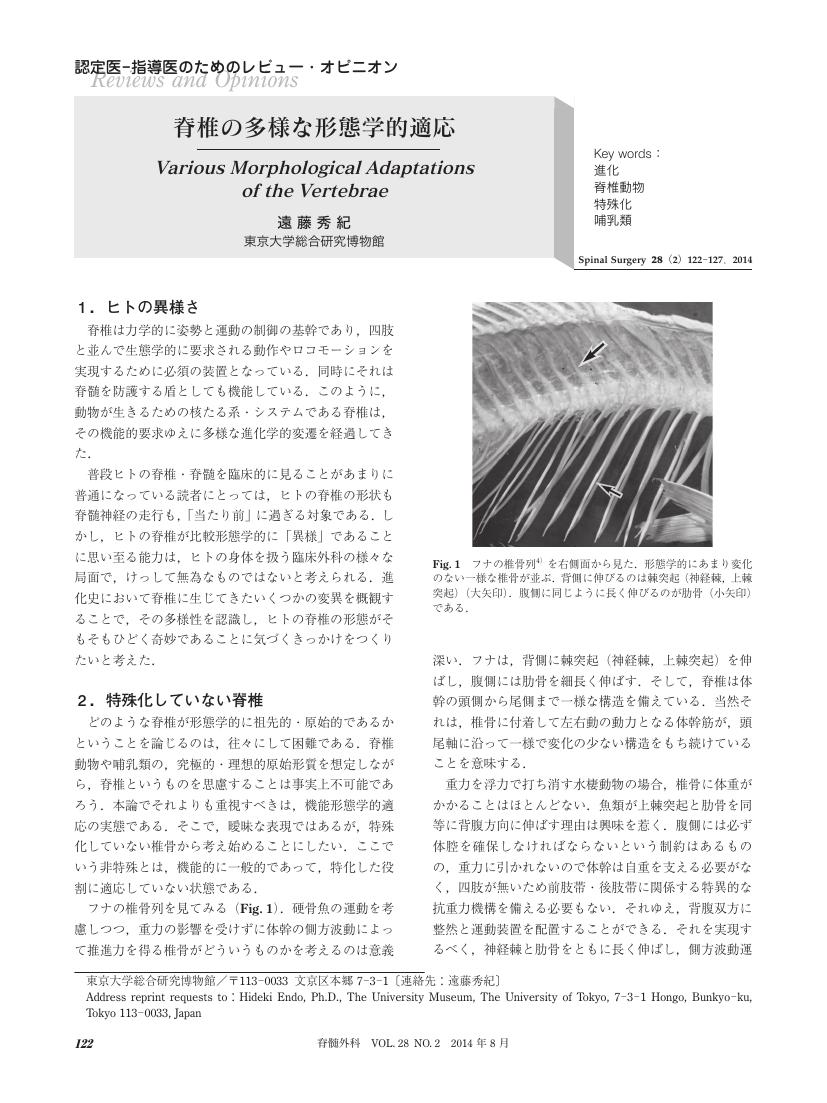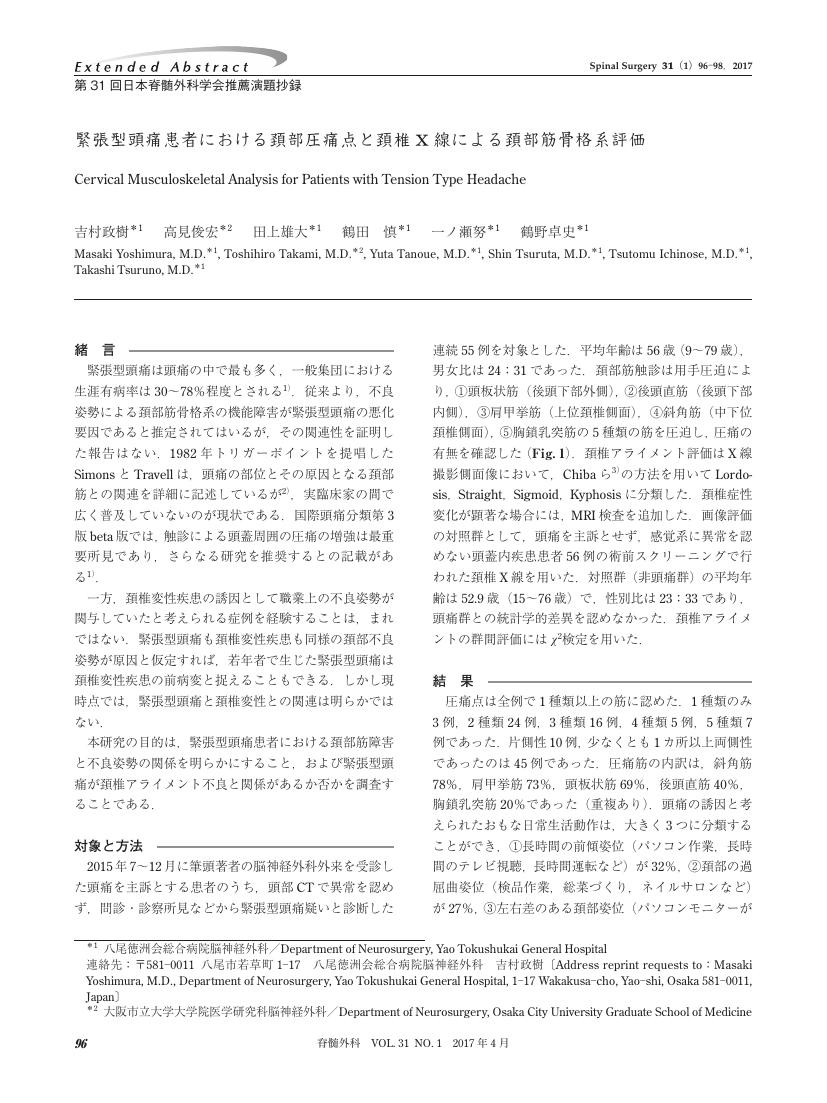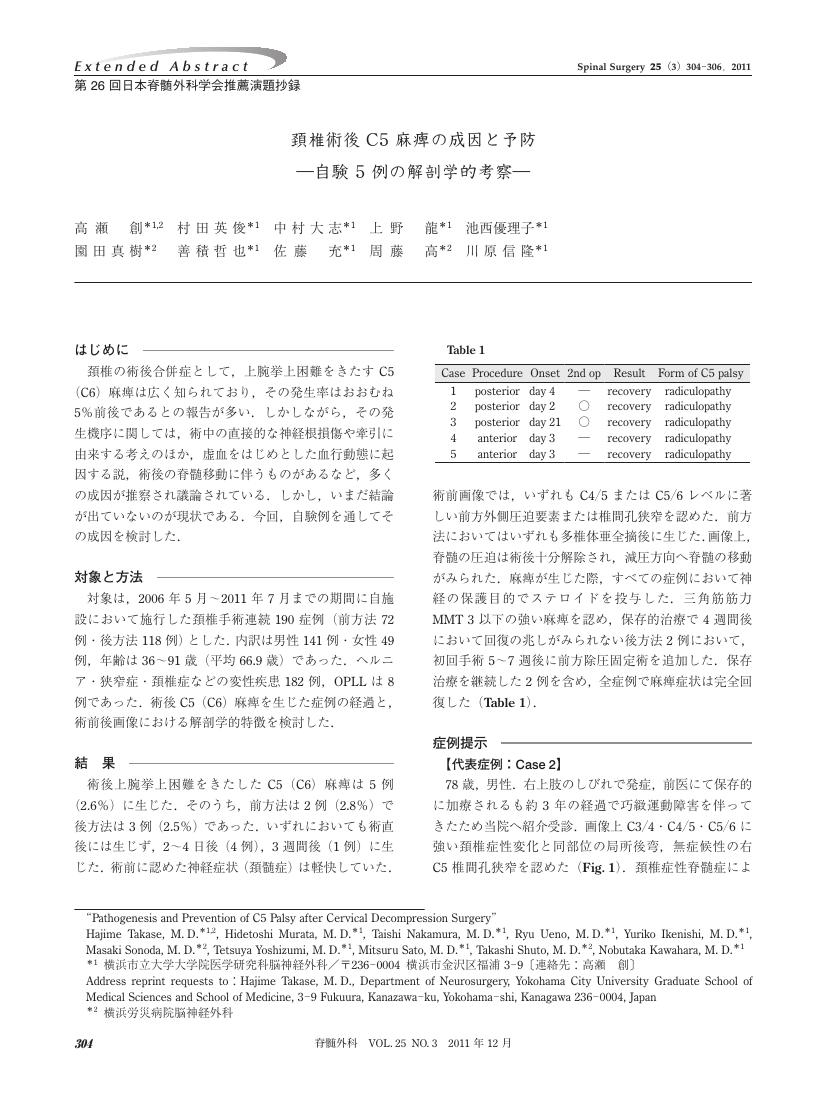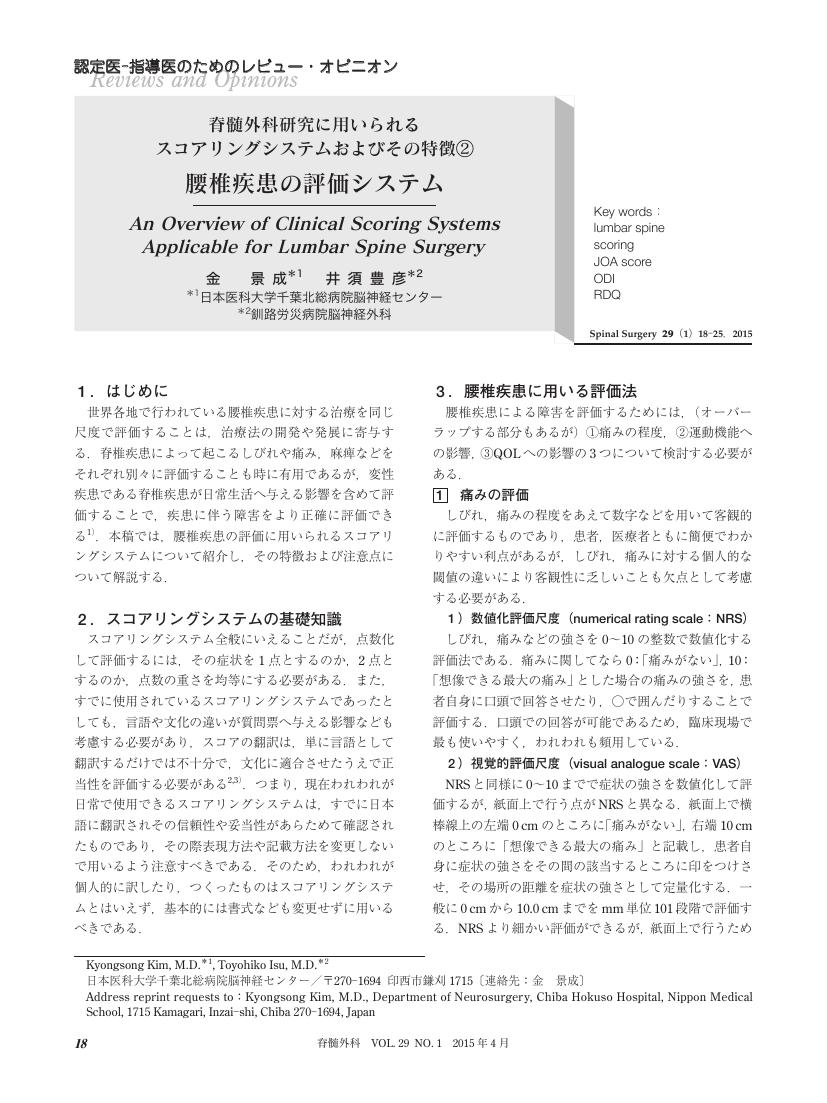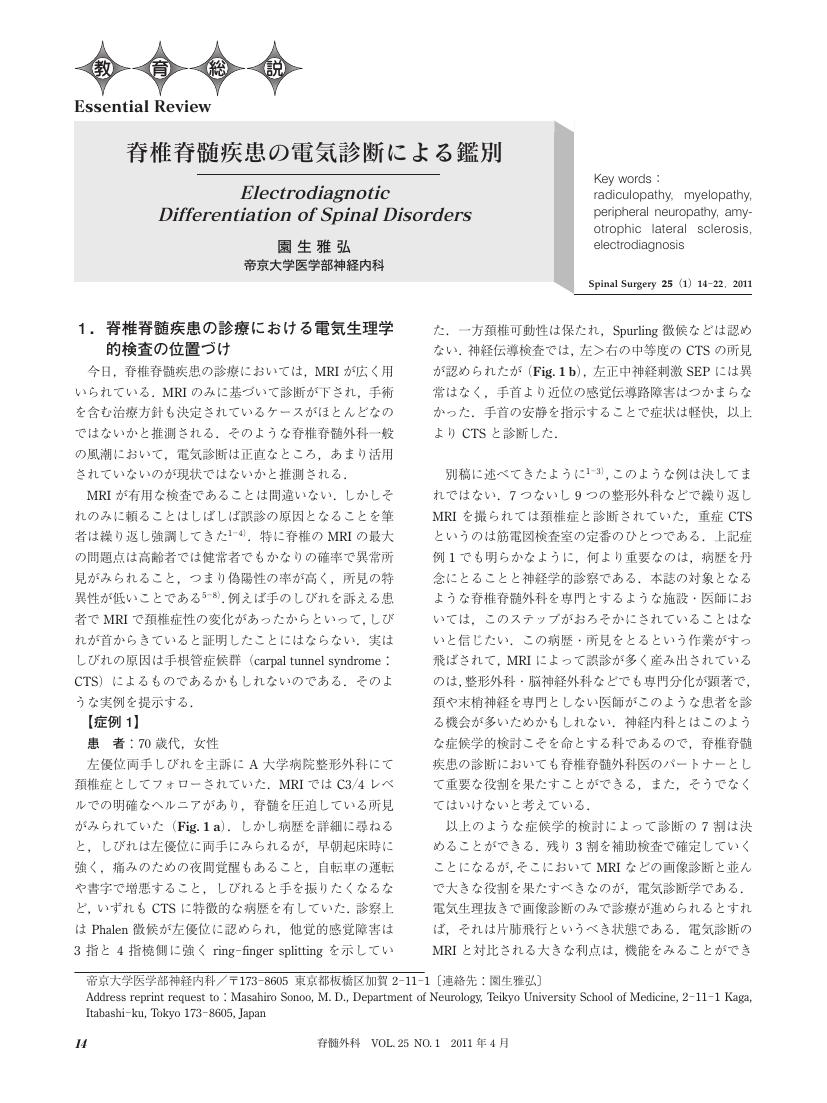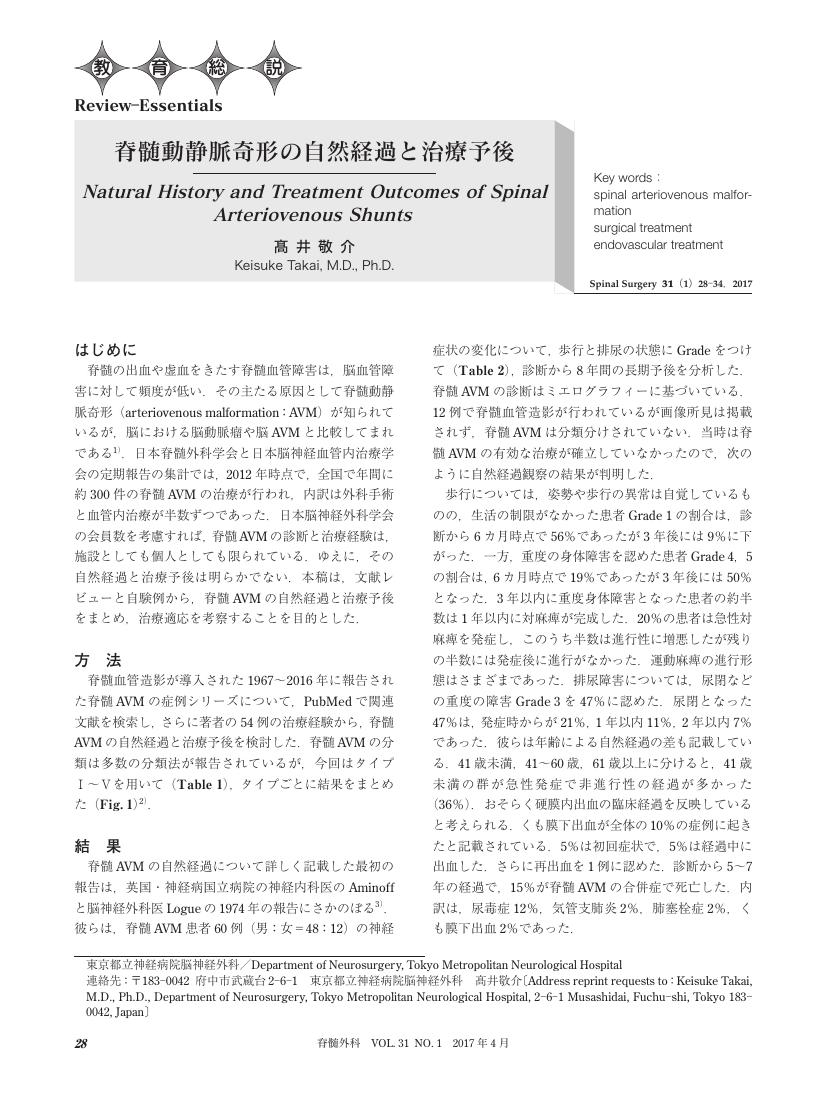4 0 0 0 OA 脊椎の多様な形態学的適応
- 著者
- 遠藤 秀紀
- 出版者
- 日本脊髄外科学会
- 雑誌
- 脊髄外科 (ISSN:09146024)
- 巻号頁・発行日
- vol.28, no.2, pp.122-127, 2014 (Released:2017-05-11)
- 参考文献数
- 4
3 0 0 0 OA もうちょっと楽しいことしないか
- 著者
- 谷口 真
- 出版者
- 日本脊髄外科学会
- 雑誌
- 脊髄外科 (ISSN:09146024)
- 巻号頁・発行日
- vol.28, no.1, pp.3-4, 2014 (Released:2017-05-11)
3 0 0 0 OA 緊張型頭痛患者における頚部圧痛点と頚椎X線による頚部筋骨格系評価
3 0 0 0 OA かゆみの脳内認知機構
- 著者
- 望月 秀紀 柿木 隆介
- 出版者
- 日本脊髄外科学会
- 雑誌
- 脊髄外科 (ISSN:09146024)
- 巻号頁・発行日
- vol.30, no.1, pp.53-57, 2016 (Released:2016-07-06)
- 参考文献数
- 32
かゆみはかきむしりたくなる不快な体性感覚であり, アトピー性皮膚炎など皮膚疾患において多く認められる症状である. また, 末梢や中枢における神経疾患においてもかゆみが症状としてあらわれることがある. かゆみの治療では抗ヒスタミン薬が一般的に用いられているが, 疾患に伴うかゆみ (慢性掻痒) には十分な効果を示さないことが多い. そのため, より効果的なかゆみの治療法開発が強く望まれている. そのためにも, かゆみや慢性掻痒のメカニズムを理解することが重要である. 1994年, はじめてかゆみの脳機能イメージング研究が報告された. その後, さまざまな研究者によって健常者や慢性掻痒患者を対象にかゆみの脳研究が行われた. さらには, 非侵襲的脳刺激法を用いたかゆみの抑制に関する研究も行われた. 本稿ではこれまでに報告されたかゆみの脳研究について概説する.
3 0 0 0 OA 痛みの不快感を緩和させる脳へのアプローチ
- 著者
- 平林 万紀彦
- 出版者
- 日本脊髄外科学会
- 雑誌
- 脊髄外科 (ISSN:09146024)
- 巻号頁・発行日
- vol.30, no.3, pp.293-295, 2016 (Released:2017-01-31)
2 0 0 0 OA 胸郭出口症候群の診断と治療戦略
2 0 0 0 OA 頚椎術後C5麻痺の成因と予防
2 0 0 0 OA 不全麻痺で発症した脊髄海綿状血管腫
2 0 0 0 OA 脊髄外科研究に用いられるスコアリングシステムおよびその特徴② 腰椎疾患の評価システム
2 0 0 0 OA 脊椎脊髄疾患の電気診断による鑑別
2 0 0 0 OA C3-4頸髄症の臨床的検討
- 著者
- 角田 圭司 森川 実 永田 泉
- 出版者
- 日本脊髄外科学会
- 雑誌
- 脊髄外科 (ISSN:09146024)
- 巻号頁・発行日
- vol.23, no.1, pp.24-28, 2009 (Released:2017-05-11)
- 参考文献数
- 9
- 被引用文献数
- 2 2
The purpose of this study is to elucidate the characteristics of C3-4 level cervical spondylotic myelopathy. This study included 11 patients, 9 men and 2 women. Mean age at admission was 75.4 years. Clinically, all of the patients had clumsy hands and gait disturbance. There was also wooziness in 7 cases. This unusual symptom may contribute to late diagnosis. Radiologically, hypermobility at the C3-4 segment compensating for decreased mobility at lower segments may induce hypertrophy of the ligamentum flavum and disc bulging. This may be related to the occurrence of C3-4 level myelopathy.
- 著者
- 髙石 吉將 荒井 篤 岡田 真幸 藤原 大悟 鵜山 淳 近藤 威
- 出版者
- 日本脊髄外科学会
- 雑誌
- 脊髄外科 (ISSN:09146024)
- 巻号頁・発行日
- vol.33, no.2, pp.179-183, 2019 (Released:2019-09-10)
- 参考文献数
- 16
Various complications are found in ventriculo-peritoneal shunts (V-P shunts) used in hydrocephalus. Overdrainage can be the source of some of these complications and is the primary cause of orthostatic headache, nausea, and vomiting. Here, we report a case of overshunting-associated myelopathy with progressive tetraparesis. A 56 year-old female had undergone placement of a V-P shunt four years prior to presentation in our clinic. She presented with progressive spastic tetraparesis and dysarthria but had no headache. In a brain magnetic resonance image (MRI), enlargement of the bilateral subdural space was noted. Gadolinium enhanced MRI showed dural enhancement. The presence of intracranial hypotension was suspected. Engorgement of the epidural vein at the C2 level in the cervical epidural space was also observed in the gadolinium enhanced cervical MRI. Since overdrainage of the V-P shunt was obviously present, a programmable valve was placed, and the flow of cerebrospinal fluid was controlled. The symptoms improved, and the epidural enhanced lesion diminished in subsequent MRIs. Here, we report a case of overshunting-associated myelopathy after placement of a V-P shunt and a review of the currently available literature.
2 0 0 0 OA 肥厚性硬膜炎の診断と治療
2 0 0 0 OA 脊髄動静脈奇形の自然経過と治療予後
- 著者
- 髙井 敬介
- 出版者
- 日本脊髄外科学会
- 雑誌
- 脊髄外科 (ISSN:09146024)
- 巻号頁・発行日
- vol.31, no.1, pp.28-34, 2017 (Released:2017-07-08)
- 参考文献数
- 21
2 0 0 0 OA 抄録、討論
- 出版者
- 日本脊髄外科学会
- 雑誌
- 脊髄外科 (ISSN:09146024)
- 巻号頁・発行日
- vol.4, pp.49-52, 1990 (Released:2017-04-22)
2 0 0 0 OA 術後髄液漏および低髄圧症候群に対する血液凝固第13因子の効果について
2 0 0 0 OA 女性や小児における脊髄疾患術中球海綿体反射 (BCR) の問題点
2 0 0 0 OA 脊髄刺激を用いた重度脊髄損傷者における歩行機能再構築の試み
- 著者
- 中尾 弥起
- 出版者
- 日本脊髄外科学会
- 雑誌
- 脊髄外科 (ISSN:09146024)
- 巻号頁・発行日
- vol.30, no.1, pp.83-87, 2016 (Released:2016-07-06)
- 参考文献数
- 39
Most patients with significant spinal cord damage have permanent symptoms and may be wheelchair-bound, depending on their residual motor function below the spinal cord lesion. Spinal cord damage, whether caused by injury or disease, is currently not repaired by any therapy. The sensory, motor, and autonomic functions of each segment depend crucially on connections with supraspinal sites for all conscious or voluntary actions. Damage to these connections leaves spinal segments caudal to the lesion site partially or totally isolated from the brain, resulting in debilitating consequences. Studies in humans have demonstrated, however, that the lumbosacral spinal circuitry retains an intrinsic capability to oscillate and generate coordinated rhythmic motor activity even when isolated from brain control. Although the anatomical architecture of locomotor central pattern generators remains poorly understood in mammals, the functional phenomenon of central pattern generation has been documented extensively. Techniques to stimulate spinal networks lend themselves as potent tools to facilitate locomotor recovery after severe spinal cord injury. Among several experimental strategies tested for activation of locomotor circuits in mammals after complete spinal cord transection, electrical stimulation has been investigated in human spinal cord injury. A recent clinical study demonstrated that some patients with complete paralysis were able to perform voluntarily controlled movements with epidural stimulation. In combination with epidural electrical stimulation of lumbosacral segments, activity-based rehabilitation can restore supraspinally mediated movements. Electrical neuromodulation therapies that activate spinal cord central pattern generators open up new avenues for treatment of spinal cord injury in human subjects.
